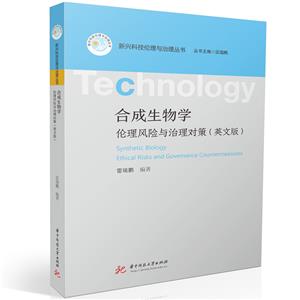包郵 合成生物學(xué):倫理風(fēng)險(xiǎn)與治理對(duì)策(英文版)
-
>
宇宙、量子和人類(lèi)心靈
-
>
氣候文明史
-
>
南極100天
-
>
考研數(shù)學(xué)專(zhuān)題練1200題
-
>
希格斯:“上帝粒子”的發(fā)明與發(fā)現(xiàn)
-
>
神農(nóng)架疊層石:10多億年前遠(yuǎn)古海洋微生物建造的大堡礁
-
>
聲音簡(jiǎn)史
合成生物學(xué):倫理風(fēng)險(xiǎn)與治理對(duì)策(英文版) 版權(quán)信息
- ISBN:9787577212371
- 條形碼:9787577212371 ; 978-7-5772-1237-1
- 裝幀:平裝
- 冊(cè)數(shù):暫無(wú)
- 重量:暫無(wú)
- 所屬分類(lèi):>>
合成生物學(xué):倫理風(fēng)險(xiǎn)與治理對(duì)策(英文版) 本書(shū)特色
《合成生物學(xué):科學(xué)、倫理與治理》一書(shū)是一本綜合性的著作,旨在向讀者展示合成生物學(xué)在科學(xué)研究中的*新進(jìn)展和主要特點(diǎn),通過(guò)結(jié)合合成生物學(xué)的實(shí)踐,從醫(yī)藥、農(nóng)業(yè)、環(huán)境等領(lǐng)域分別闡述合成生物學(xué)的倫理爭(zhēng)議,對(duì)比各國(guó)的治理方案和政策方針,并提出合成生物學(xué)的倫理治理框架。本書(shū)即具有學(xué)術(shù)的前沿性,也具有科普上的傳播性。
合成生物學(xué):倫理風(fēng)險(xiǎn)與治理對(duì)策(英文版) 內(nèi)容簡(jiǎn)介
合成生物學(xué)作為認(rèn)識(shí)生命的“鑰匙”、改變未來(lái)的顛覆性技術(shù),打開(kāi)了從非生命物質(zhì)向生命物質(zhì)轉(zhuǎn)化的大門(mén),實(shí)現(xiàn)生命體系的理性設(shè)計(jì)與編輯,為生命科學(xué)研究提供了新范式,促進(jìn)生物技術(shù)迭代發(fā)展,成為未來(lái)生物產(chǎn)業(yè)發(fā)展的驅(qū)動(dòng)力。經(jīng)過(guò)20余年的發(fā)展,合成生物學(xué)領(lǐng)域已取得系列突破,創(chuàng)新應(yīng)用逐步實(shí)現(xiàn)。近年合成生物學(xué)的快速發(fā)展也帶來(lái)了許多倫科學(xué)、倫理和治理上的問(wèn)題和挑戰(zhàn)。在科學(xué)的維度,合成生物學(xué)從生物技術(shù)、生物工程學(xué)科逐步過(guò)渡到現(xiàn)在的形態(tài),其科學(xué)特征以及學(xué)科體系的基礎(chǔ)仍需要進(jìn)一步說(shuō)明和澄清。在倫理和治理上,合成生物學(xué)的發(fā)展和應(yīng)用引起許多決策者和利益相關(guān)方的關(guān)切,如是否應(yīng)該合成生命系統(tǒng)、合成生物學(xué)是否會(huì)帶來(lái)分配的不公正、是否有適當(dāng)?shù)闹贫葋?lái)管理這些技術(shù),以及公眾如何、何時(shí)參與這些決策。《合成生物學(xué):科學(xué)、倫理與治理》從合成生物學(xué)的學(xué)科特征及其發(fā)展態(tài)勢(shì)、合成生物學(xué)中的重要倫理問(wèn)題及治理方案和合成生物學(xué)的倫理治理框架等方面進(jìn)行了闡述。
合成生物學(xué):倫理風(fēng)險(xiǎn)與治理對(duì)策(英文版)合成生物學(xué):倫理風(fēng)險(xiǎn)與治理對(duì)策(英文版) 前言
ForewordSynthetic biology, as an emerging scientific field, stands at the forefront of scientific innovation, promising unprecedented advancements in our ability to understand, manipulate, and create biological systems.This field holds immense potential to revolutionize medicine, agriculture, energy production, and countless other aspects of human life.However, accompanying these groundbreaking capabilities are significant ethical, safety, and governance challenges that we must address to ensure the responsible development and application of synthetic biology.This book delves into the complex and multifaceted issues arising from this rapidly evolving discipline.It examines the profound ethical questions raised by the ability to design and construct new biological systems not found in nature.What does it mean to “create” life, and what are the ethical limits of manipulating the building blocks of life itself? How can we ensure that the pursuit of scientific progress in synthetic biology aligns with our values and benefits humanity as a whole?Beyond the philosophical considerations, this book tackles the safety and security risks associated with synthetic biology.How can we mitigate the risks of the accidental release of synthetic organisms or their components? How can we safeguard against malicious actors seeking to exploit these technologies for harmful purposes? To address these challenges, we need robust regulatory frameworks, international collaboration, and ongoing dialogue between scientists, policymakers, and the public.Facing the tension between the rapid development of synthetic biology and the ethical and governance challenges it presents, Chinas Ministry of Science and Technology, for the first time in 2018, incorporated research on the ethical and policy framework of synthetic biology into the National Key Research and Development Program.This book is a significant outcome of the project “Research on the Framework of Ethical Governance on Synthetic Biology”(2018YFA0902400). During this project, our team has published a series of research articles on various aspects of synthetic biology ethics and governance.This book builds upon those published findings, offering a comprehensive and systematic analysis of the ethical risks and governance countermeasures in synthetic biology. It aims to provide valuable ethical and governance references for the development of synthetic biology.This book delves into the multifaceted issues that arise from this rapidly evolving discipline. As synthetic biology enables the design and construction of new biological systems not found in nature, it challenges traditional views of life, human status in nature, and the relationship between humans and the natural world.These challenges have sparked intense ethical debates and raised questions about the legitimacy and acceptability of synthetic biology.This book is structured to provide a comprehensive examination of the ethical controversies, risk assessments, and governance strategies pertinent to synthetic biology.It is divided into three main parts.Ethical Debates on Synthetic BiologyThis part explores the philosophical and ethical arguments surrounding synthetic biology, including the contentious “playing God” argument, and appeals to nature argument and biocentrist argument.It critically analyzes these debates and highlights the deficiencies and complexities inherent in these ethical positions.Additionally, this part also explores the application of various ethical theories to synthetic biology, such as grappling with the applicability of responsibility ethics within synthetic biology.Furthermore, the discussion extends to the concerning phenomenon of “ethics dumping” in synthetic biology, highlighting instances where potentially controversial research migrates to regions with more lenient ethical oversight.This critical examination of ethical considerations underscores the books commitment to fostering a holistic understanding of synthetic biology, acknowledging both its vast potential and the complex ethical challenges it presents.Risk Analysis in Synthetic BiologyThe second part of the book focuses on the various risks associated with synthetic biology, especially in environmental, biofuel and biometric technology. It provides a detailed overview of participant safety, biosafety and biosecurity risks, and discusses the principles and practical recommendations for ethical governance, such as assessing the potential risks and benefits of this technology, highlighting the ethical dilemmas associated with its development and deployment, and proposing a governance framework.Governance Countermeasures in Synthetic BiologyThe last part presents an ethical framework for the governance of synthetic biology.It emphasizes the importance of precautionary principles, stakeholder interests, and dynamic riskbenefit assessments.This part also discusses the need for robust biosafety management frameworks and the integration of ethical principles into policy and regulatory measures.By examining these critical aspects, this book aims to provide a balanced and informed perspective on the challenges and opportunities presented by synthetic biology.It seeks to contribute to the ongoing discourse on how to navigate the ethical and governance landscape of this transformative field, ensuring that its development is both innovative and responsible.We hope that this book will serve as a valuable resource for researchers, policymakers, ethicists, and anyone interested in the ethical and governance dimensions of synthetic biology.National Key R D Program“Research on the Framework of Ethical Governance on Synthetic Biology”(2018YFA0902400) GroupIntroductionSynthetic Biology: Ethical Risks and Governance Countermeasures is structured to provide a comprehensive examination of the ethical controversies,risk assessments,and governance strategies pertinent to synthetic biology. It is divided into three main parts.Part Ⅰ explores the ethical arguments on synthetic biology,including the contentious “playing God” argument, and appeals to nature argument and biocentrist argument. It critically analyzes these debates and highlights the deficiencies and complexities inherent in these ethical positions.Additionally,this part also explores the application of various ethical theories to this rapidly evolving field,such as grappling with the applicability of responsibility ethics within synthetic biology, and questioning the boundaries and limits of accountability when dealing with engineered organisms. Furthermore,the discussion extends to the concerning phenomenon of “ethics dumping” in synthetic biology,highlighting instances where potentially controversial research migrates to regions with more lenient ethical oversight.Part Ⅱ focuses on the various risks associated with synthetic biology,particularly in biomedical applications.It provides a detailed overview of participant safety,biosafety,and biosecurity risks,and discusses the principles and practical recommendations for ethical governance. This part also addresses the risks of the application of synthetic biology,such as the environmental risks posed by synthetic biology,analyzes the limitations of existing risk governance strategies, offers recommendations for the ethical governance of this powerful technology, and explores the ethical considerations surrounding synthetic biofuels.It assesses the potential risks and benefits of this technology, proposes a framework for the prospective governance of synthetic biofuels,emphasizing ethical considerations, and addresses the privacy implications of biometric technology,a field closely intertwined with synthetic biology. It analyzes the challenges posed by biometric technology to privacy protection and proposes principled responses to address these concerns,particularly in the context of China.Part Ⅲ, the final part presents an ethical framework for the governance of synthetic biology. It proposes a principlebased approach to governance in synthetic biology, which emphasizes the importance of precautionary principles,stakeholder interests,and dynamic riskbenefit assessments. Under this framework,this part also discusses the integration of ethical principles into policy and regulatory measures, and the application of the framework in the context of biosafety and biosecurity in synthetic biology. It also analyzes the applicability of the Cartagena Protocol on Biosafety to synthetic biological products.It reviews the progress of international negotiations on this issue within the framework of the Convention on Biological Diversity and discusses its applicability in synthetic biology.By examining these critical aspects, this book aims to provide a balanced and informed perspective on the challenges and opportunities presented by synthetic biology.It seeks to contribute to the ongoing discourse on how to navigate the ethical and governance landscape of this transformative field,ensuring that its development is both innovative and responsible.
合成生物學(xué):倫理風(fēng)險(xiǎn)與治理對(duì)策(英文版) 目錄
ContentsPART ⅠEthical Debates on Synthetic Biology1An Analysis of the “Playing God” Argument against Synthetic Biology1.1Introduction1.2The Origin of “Playing God” Argument1.3The Interpretation of the Expression of Playing God1.4The Debate on Whether Synthetic Biology “Plays God”1.5Deficiencies of “Playing God” as an Argument1.6References2Some Remarks on the Argument Appealing to Nature against Synthetic Biology2.1Introduction2.2The Argument Appealing to Nature against Synthetic Biology and an Analysis of Its Deficiencies2.3Ambiguity of the Concept Nature2.4Problems in the Morally Significant Line between the Natural and the Non/Unnatural2.5Allegations to Synthetic Biology Stemming from Argument Appealing to Nature2.6Conclusion2.7References3On the Biocentrist Argument against Synthetic Biology3.1Introduction3.2Biocentrism and Its Advocates: A Critique of Synthetic Biology3.3Argument Appealing to Natural Evolutionary History3.4Argument Appealing to Teleological Organization3.5Argument Appealing to the Good of Own or Interests3.6References4Research on Responsibility Ethics of DNA Synthesis Technology4.1Introduction4.2Ethics of Responsibility of Hans Jonas4.3The Necessity of Applying Ethics of Responsibility in DNA Synthesis Techniques4.4Application of Ethics of Responsibility in the Practice of DNA Synthesis Technology4.5Suggestions for Applying Ethics of Responsibility in the Practice of DNA Synthesis Technology4.6Conclusion4.7References5Analysis of Ethics Dumping and Proposed Solutions in the Field of Biomedical Research in China5.1Introduction5.2The Definition of Ethics Dumping5.3Typical Cases of Ethics Dumping in Biomedical Research in China5.4Analysis of the Causes of Ethics Dumping in Biomedical Research in China5.5Policy Recommendations5.6ReferencesPART ⅡRisk Analysis in Synthetic Biology6Safety Risks and Ethical Governance of Biomedical Applications of Synthetic Biology6.1Introduction6.2The Biomedical Applications of Synthetic Biology6.3An Analysis of the Safety Risks of the Application of Synthetic Biology within Biomedicine6.4Ethical Considerations in the Application of Synthetic Biology within the Biomedical Field6.5Recommendations for Ethical Governance of Biomedical Applications of Synthetic Biology6.6Conclusion6.7References7Risks and Governance Recommendation for Synthetic Virus Technology from an Ethical Perspective7.1Introduction7.2Synthetic Virus Technology and Kinds of Risks7.3Challenges Faced by Existing Risk Governance Strategies7.4Governance Recommendations for Synthetic Virus Technology7.5Conclusion7.6References8Ethical Perspective on the Risk Assessment and Prospective Governance of Synthetic Biofuels8.1Introduction8.2Risk Assessment and Ethical Issues of Synthetic Biofuels8.3Prospective Governance of Synthetic Biofuels from an Ethical Perspective8.4Conclusion8.5References9Challenges and Principled Responses to Privacy Protection from Biometric Technology in China9.1Introduction9.2The Definition of Biometric Technology and Biometric Characteristics9.3The Challenges of Biometric Technology for Privacy Protection9.4Principled Responses to Privacy Protection from Biometric Technology9.5Conclusion9.6ReferencesPART ⅢGovernance Countermeasures in Synthetic Biology10Ethical Framework on Risk Governance of Synthetic Biology10.1Introduction10.2The Relationship between Environmental Risk and Synthetic Biology10.3Methods for Environmental Risk Assessment of Synthetic Biology10.4Ethical Principles in Environmental Risk Governance10.5Conclusion10.6References11Establishing a Management Framework for Biosafety Risk Assessments of Synthetic Biology11.1Introduction11.2Synthetic Biology Enabling Technology11.3Biosafety Risk Assessments of Synthetic Biology11.4Framework for Biosafety Risk Assessments11.5Discussion11.6Summary11.7References12Risks and Countermeasures of LaboratoryAcquired Infection Based on Pathogen Transmission Routes12.1Introduction12.2LAI Risk Analysis Based on Transmission Routes12.3Response to LAIs with Different Transmission Routes12.4Comprehensive Strategy12.5Conclusion12.6References13Regulation and Management of the Biosecurity for Synthetic Biology13.1Introduction13.2Biosecurity Risks of Synthetic Biology13.3Situation of the Regulation and Management of Biosecurity for Synthetic Biology in the International Community13.4Situation of the Regulation and Management of Biosecurity for Synthetic Biology in China13.5Suggestions on the Regulation and Management of Biosecurity for Synthetic Biology in China13.6Conclusion13.7References14Can Synthetic Biological Products Be Applied to the Cartagena Protocol on Biosafety?14.1Introduction14.2Progress in the Negotiation of Synthetic Biology under the Framework of the CBD14.3Application of Synthetic Biological Products under the Rules of the Biosafety Protocol14.4Conclusion14.5References15A Leap of Faith: Building the Trust in Human Biobanks15.1Introduction15.2Theoretical Foundations of Public Trust in HBs: A Leap of Faith15.3Is There a Universal Formula for the Construction of Public Trust in HBs?15.4Schemes for the Establishment and Reinforcement of Public Trust in HBs15.5Conclusion15.6References
合成生物學(xué):倫理風(fēng)險(xiǎn)與治理對(duì)策(英文版) 作者簡(jiǎn)介
電子科技大學(xué)馬克思主義學(xué)院教授/博導(dǎo),科技倫理治理研究中心主任。2019年5月9日在國(guó)際*科學(xué)期刊Nature發(fā)表國(guó)內(nèi)人文學(xué)科領(lǐng)域第一篇研究論文“Reboot Ethics Governance in China”(《重建中國(guó)的倫理治理》),在國(guó)內(nèi)首次提出“科技倫理治理”和“倫理先行”概念,并系統(tǒng)闡述科技倫理治理基本原則,相關(guān)概念和原則已被系列中央文件和兩辦《關(guān)于加強(qiáng)科技倫理治理意見(jiàn)》采納。生命倫理學(xué)創(chuàng)始研究機(jī)構(gòu)Hastings中心Fellow,中國(guó)自然辨證法研究會(huì)理事,中國(guó)倫理學(xué)會(huì)常務(wù)理事。
- >
名家?guī)阕x魯迅:朝花夕拾
- >
羅庸西南聯(lián)大授課錄
- >
朝聞道
- >
月亮虎
- >
唐代進(jìn)士錄
- >
山海經(jīng)
- >
經(jīng)典常談
- >
史學(xué)評(píng)論














